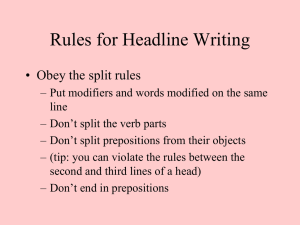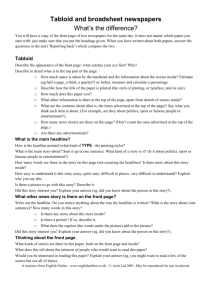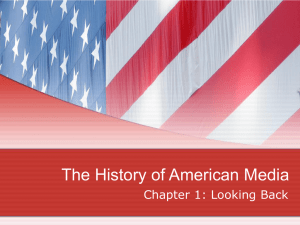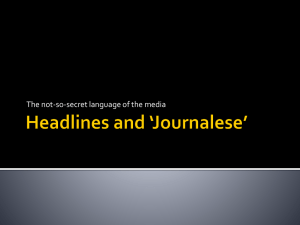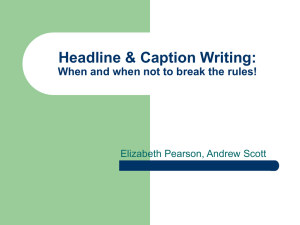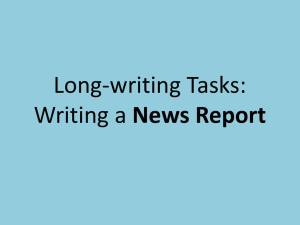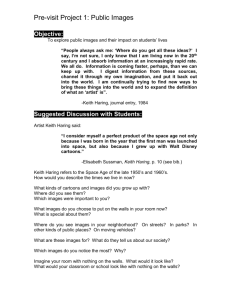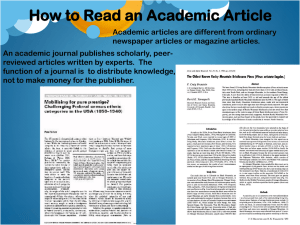THE LANGUAGE OF THE NEWS
advertisement
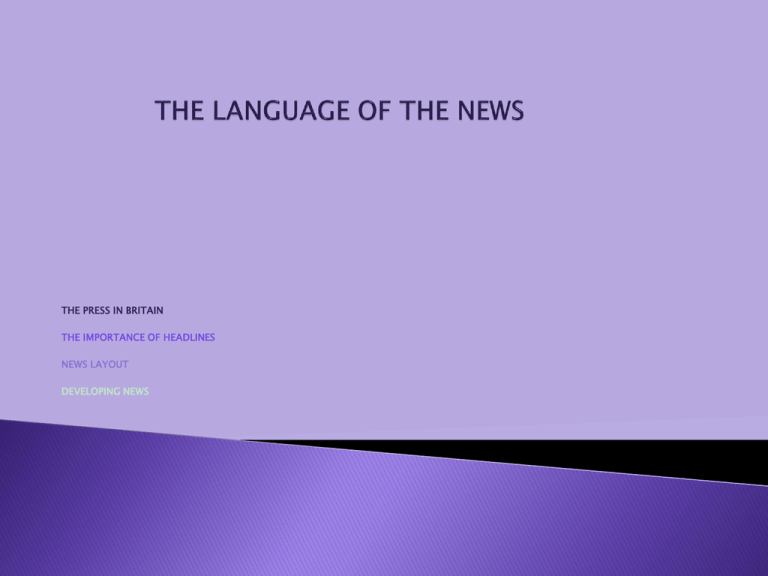
THE PRESS IN BRITAIN THE IMPORTANCE OF HEADLINES NEWS LAYOUT DEVELOPING NEWS • DAILY PAPERS • SUNDAY PAPERS • LOCAL PAPERS • EVENING PAPERS • THE FREE PRESS QUALITY PAPERS: also known as HEAVIES, they deal with hard POPULAR PAPERS: also known as GUTTER PRESS/TABLOIDS, news (politics, home affairs, foreign affairs, finance, economics, etc); they are intended for a well-educated reading public. they deal with soft news (human interest stories, about famous people); they are intended for the mass (ordinary people) QUALITY AND POPULAR PAPERS DIFFERENCES IN THE APPROACH TO THE NEWS Size typography news paragraphs lexis QUALITY PAPERS Size: large format Typography: few pictures News attitude: hard news, both reports and comments Paragraphs: long Lexis: both neutral and non-neutral; complex and dense POPULAR PAPERS Size: small format (tabloids) Typography: large block headlines, a lot of pictures and photographs News attitude: soft news (human interest stories) Paragraphs: short Lexis: simple, non-neutral, rich in contrasts (comparatives and superlatives) REPORTS Any news article which gives information about something that has just happened in order to narrate neutrally COMMENTS/EDITORIALS Any article which gives the writer’s opinion Most modern newspapers have three sizes: BROADSHEET : generally associated with more intellectual newspapers. It is the largest of the newspapers formats and is characterized by very long vertical pages. The term derives from types of popular prints usually just of a single sheet, sold on the streets and containing various types of matters, from ballads to political satire. The most important British newspapers in this format are : The Daily Telegraph, the Times, The Financial Times, etc. TABLOID : is half the size of the broadsheet and focuses on local-interest stories and entertainment, emphasises sensational crime stories: gossip columns deal with the personal life of celebrities and sport stars, and also called “junk food news”. The most important British newspapers in this format are : The Sun, the Daily Mail, The Daily Express, The Daily Mirror, etc. BERLINER : is slightly taller and marginally wider than the tabloid, and is both narrower and shorter than the broadsheet format The most important British newspapers in this format are : The Guardian and The Observer They regularly appear after 1870. The crucial factor in their evolution was the use of the telegraph in the American civil war. The functions of a headline are: To attract the reader’s attention To indicate the writer’s attitude To summarize the content of the article To indicate the focus of the article Newspapers headlines have special linguistic characteristics SPECIALISED VOCABULARY: words are unusual, sensational and short; language is distinctive and telegraphic; RHETORICAL DEVICES: headlines play with words (metaphors, puns, assonances, consonances, etc.); INTERNALLY CONSISTENT GRAMMAR Newspapers headlines have special linguistic characteristics THEY PLAY WITH KNOWLEDGE: they focus on the reader’s cultural knowledge; REGISTER: the register differs according to field (economics, politics, science, etc), tenor (formal/informal, technical/nontechnical, neutral/emotional, etc.); MODE: formal vs informal Newspapers headlines play with the reader’s knowledge: SUBSTITUTION: it occurs when a grammatical/lexical item, a homophone or a single letter is substituted ABBREVIATION: a well-known expression is quoted in abbreviated form INSERTION: an additional item is inserted into a well-known expression REPHRASING: an expression is altered in some way Who writes the headline? The subeditor/s When does s/he does it ? Before being printed, when the journalist has already written the article What do headlines convey? They abstract the story, they do not have to begin it Why are headlines personalised? It depends on factors, such as the newspaper’s house style, and the subject matter. Some subjects require formal treatment, others do not. VERBALISATION VS NOMINALISATION The headline is verbalised when the main clause is not dominated by a noun phrase but by a verb. Ex: Phones are the new cars E- commerce takes off PssT, wanna buy a kidney? Can Angel Merkel hold Europe together? That’s all folks Don’t lie to me Argentina We like to move it move it Come and get me VERBALISATION VS NOMINALISATION The headline is nominalised when the main clause is dominated by a noun phrase. Ex: Out of the limelight Time for super Mario Out with the long Less Mary Poppins Mamma mia Decision time Of music, murder and shopping No time for doubters VERBALISATION The verb gives energy, liveliness and pace to the headline The message is clear, unambiguous, and not deviant The journalist’s position is neutral It has a reporting function NOMINALISATION It obstacles the reader’s interpretation It makes the message more ambiguous, the language is more deviant It underlines the journalist’s position/opinion It attracts the reader’s attention It is an excellent tool to summarize the article While writing articles the journalist must respect the rules of communication: QUALITY: do no say things which are not true QUANITY: do not say either too much or too little RELEVANCE: do not say things which are not connected with MANNER: be brief, be ordered, be clear, be simple the discourse News stories are socially created; to be published they must respect the general criteria of newsworthiness. News must be: Real: no invention Unambiguous: clearly developed and respectful of the cultural proximity In agreement with the reading public as much as possible Clearly stereotyped: the readers are supposed to understand Topic-oriented: the importance of a subject depends on where it is seen from As Labov (1969) stated, stories have a beginning, a middle, and an end. A fully-formed narrative story respects the following pattern: Abstract Orientation Action Evaluation Result or resolution coda NEWS STORIES have a structure, direction, point, and a Viewpoint (Bell: 1991, 1995,1996) Abstract vs Lead The abstract corresponds to the lead/1st paragraph and the headline: the lead summarizes the central action and it establishes the main point of a news story. The headline is the abstract of the abstract, it appears as the first abstract in the printed story. The orientation In narratives and news stories it sets the scene: who the actors are, where, and when the events take/took place, what the initial situation is/was. In the news it is necessary. For journalists who, what, when and where Are the basic facts which are concentrated at the beginning of the story, but may be expanded further down. Action At the heart of a personal narrative the action corresponds to the sequence of events which occurred, it is the temporal sequence of its sentences; in news stories, by contrast, events are seldom if ever told in chronological order (the body of the story). evaluation The evaluation, which in narratives distinguishes a directionless sequence of sentences from a story, in news stories has the same function; it establishes the significance of what is being told, it focuses on the events, and justifies them claiming the reading public’s attention. Resolution The personal narrative moves to a resolution. News stories often do not present such clearcut results. When they do, the result will be in the lead rather than at the end of the story. News stories are not temporally structured, or turned in a finished fashion. coda The coda, which is widely used in personal narratives, does not appear in news stories. There are three additional categories in news stories: Background: it represents the past; it covers any events prior to the current action-story. Commentary: it represents the present, it provides the journalist’s present-time observations on the action, assessing, and commenting on events as they happen. It may provide the context to assist understanding of what is happening, evaluative comment on the action, expectations of how the situation will develop. Follow up: it represents the future; it covers the story futuretime, any action subsequent to the main action of an event. It can include verbal reaction by other parties or non-verbal consequences. THE INVERTED PYRAMID CONCEPT (Van Dijk, 1988) Concentration of information in the lead, headline, sub-headline Developing of information in the body/action, where events are not developed respecting a chronological order HOW DO THE JOURNALISTS DEVELOP THE NEWS? While communicating there must be a balance between new information and given information. given information generally comes at the beginning (theme); new information generally comes at the end (rheme); HOW DO THE JOURNALISTS DEVELOP THE NEWS? While communicating the new element(s), the journalist keeps the readers interested because this is new for them; they are told something they did not know. If all the information were new, without any anchor in shared knowledge, they would not be able to absorb the load. BREVITY AND EFFICIENCY: information is incapsulated into limited spaces, with respect for the effect it has on the audience IMPRESSIVNESS : sensational words are chosen DEVIANCE: deviant language is used to attract, to persuade PERSUASIVENESS: relevant lexical and grammatical items are selected QUOTATIONS (journalists quote for three main different reasons) 1. NEUTRALITY : a quote is an unquestionable fact 1. DISTANCE: to absolve the journalist 1. TRUTHNESS: to add the story the flavour of the newsmaker’s own words LANGUAGE (to attract the reader’s attention, the journalist uses) COLLOQUIAL TERMS: spoken language allow everybody to feel comfortable with both given and new information FIGURES OF SPEECH: to produce colourfulness and liveliness high deviance, suspense,
